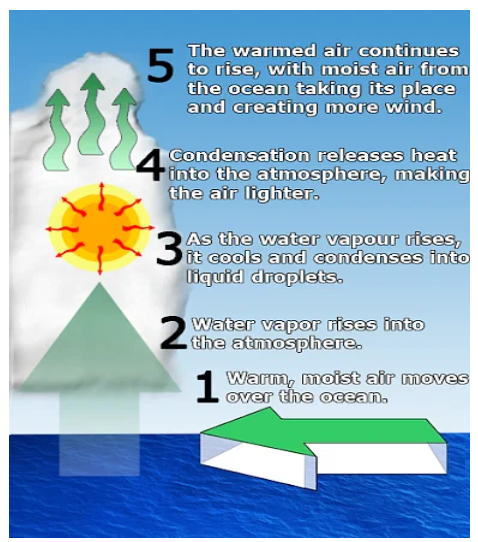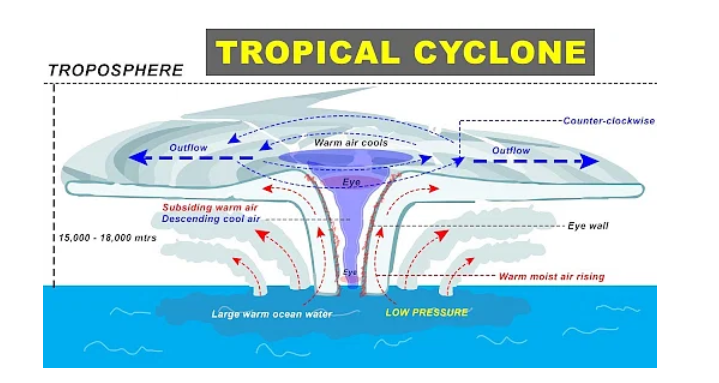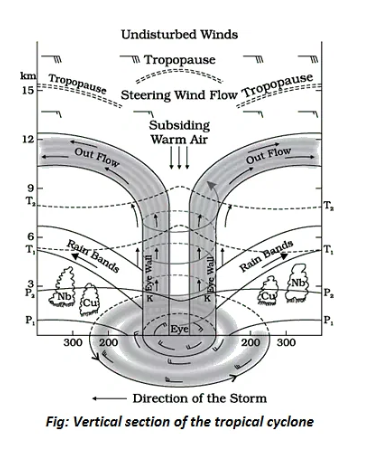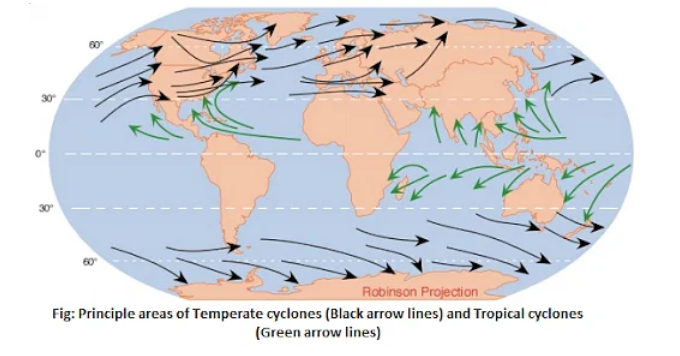CYCLONE
- Cyclones represent a specific kind of low-pressure system characterised by swift, inward air movement.
- In the Northern Hemisphere, these storms exhibit a counterclockwise flow of air, whereas in the Southern Hemisphere, the circulation follows a clockwise pattern.
- Cyclones are often linked with stormy and inclement weather conditions.
- The term "Cyclone" finds its origins in the Greek word "Cyclos," meaning coiled snake.
- This term was coined by Henry Paddington, attributing the name to the resemblance of tropical storms in the Bay of Bengal and the Arabian Sea to the coiled forms of sea serpents.
FORMATION OF CYCLONE
Cyclogenesis is a fundamental process contributing to the formation and intensification of cyclones, encompassing various atmospheric activities.
- Tropical cyclones, for instance, emerge near the equator, mainly over warm ocean waters.
- The initial phase involves the ascent of warm, moisture-laden air from the ocean's surface, generating a low-pressure area near the surface.
- Cooler air from the surrounding regions converges into this low-pressure zone. As this colder air is now warmed and moistened, it, too, ascends.
- This cycle perpetuates, sustaining the low-pressure system and the upward movement of warm, humid air.
- This cyclical pattern of rising warm air, subsequent cooling, and condensation leads to the formation of clouds.
- The process repeats, fostering the development of a cyclone. When wind speeds exceed 63 miles per hour, the system is classified as a tropical storm.
- As winds escalate to around 119 miles per hour or more, it is deemed a tropical cyclone or hurricane.

NOMENCLATURE OF CYCLONE
- An international committee under the World Meteorological Organization (WMO) is responsible for managing and revising lists of cyclone names.
- Originally, only women's names were included in the lists.
- However, in 1979, men's names were incorporated as well. These names, male and female, are used in an alternating sequence.
- There are six distinct lists that are employed in a rotational manner. For instance, the list utilised in 2020 will be repeated in 2026 as part of this rotational pattern.
- If a cyclone has caused significant damage or devastation in a specific country, the names associated with those storms will not be reused in the future, for obvious reasons.
Cyclones can be classified into two primary types:
- Tropical Cyclones
- Temperate Cyclones (also known as Extratropical cyclones, Middle-latitude cyclones, Frontal cyclones, or Wave Cyclones).
TROPICAL CYCLONE
The World Meteorological Organization defines 'Tropical Cyclone' as a weather system characterised by winds stronger than 'Gale Force' (minimum of 63 km per hour).
- Tropical cyclones form within the region between the Tropic of Capricorn and the Tropic of Cancer.
- These large-scale weather systems originate over tropical or subtropical oceans and develop a circulation of surface winds.
- They are formidable storms emerging over tropical oceans and then moving inland, often causing destruction due to their violent winds, intense rainfall, and storm surges.
These cyclones are among the most devastating natural disasters globally. They develop over warm tropical oceans and intensify under specific favourable conditions:
- Presence of a large sea surface area with a temperature exceeding 27° C.
- Existence of the Coriolis force.
- Slight variation in vertical wind speed.
- The presence of a pre-existing weak low-pressure area or low-level cyclonic circulation.
- Higher divergence above the sea-level system.

FORMATION OF TROPICAL CYCLONE
Tropical cyclones undergo distinct phases throughout their lifecycle:
Formation and Initial Development Stage
- During this stage, the warm ocean provides the necessary heat and moisture to foster the formation and early development of a cyclone.
- Water vapour and heat from the ocean surface, primarily through evaporation, are transported to the overlying air.
- This process encourages the generation of towering cumulus clouds through convection and the subsequent condensation of rising air.
Mature Stage
- As a tropical storm matures, the air rises vigorously in powerful thunderstorms and tends to spread horizontally at the tropopause level.
- This horizontal spreading leads to the creation of a positive pressure at higher altitudes, accelerating the descent of air due to convection.
- The downward motion leads to compression and subsequent warming of the air, forming the warm 'Eye' at the cyclone's centre.
- In the Indian Ocean, a mature cyclone often exhibits a concentric pattern of large, turbulent cumulus thundercloud bands as a key characteristic.
Modification and Decay
- A tropical cyclone begins to weaken when its warm, moist air source diminishes or is abruptly cut off.
- Factors such as landfall or traversing over cooler waters contribute to this process.
- This weakening results in reduced core low pressure, internal warmth, and decreased wind speeds, signifying the cyclone's decay.

TEMPERATE CYCLONE
- Extratropical cyclones go by various names including mid-latitude depressions, temperate cyclones, frontal depressions, and wave cyclones.
- These cyclones are active within the mid-latitudinal zone, typically between 35° and 65° latitude, in both the northern and southern hemispheres.
- They generally move from west to east and are notably active during the winter months.
- Within these latitudinal zones, collisions between polar and tropical air masses occur, leading to the creation of various fronts.

FORMATION OF TEMPERATE CYCLONE
- The Polar Front theory provides a comprehensive explanation for the development and progression of temperate cyclones.
- According to this concept, a polar front arises from the convergence of warm, moist air masses from the tropics and cold, dry air masses from the poles.
- Due to its higher density, the cold air mass displaces the warmer one, causing it to rise.
- This collision generates instability, leading to a drop in pressure at the convergence point, particularly at the heart of this interaction.
- This pressure drop creates a void, subsequently filled by the surrounding air, and the Earth's rotation contributes to the formation of a cyclone.
- Extratropical cyclones differ from the more intense tropical cyclones or hurricanes, which primarily occur in relatively uniform temperature zones.
SIGNIFICANCE OF CYCLONE
- Cyclones play a crucial role in transferring heat and energy from tropical to temperate latitudes.
- This characteristic makes them a vital element in the overall global atmospheric circulation system.
- Cyclones aid in replenishing aquifers, maintaining balanced ocean temperatures, and facilitating the transportation of nutrients into the sea by augmenting the flow of rivers and streams that carry sediment and other material.
FAQs regarding Cyclones
1. What are Cyclones?
Ans. Cyclones represent a specific kind of low-pressure system characterised by swift, inward air movement. They exhibit a counterclockwise flow of air in the Northern Hemisphere and a clockwise flow in the Southern Hemisphere. Often, cyclones are linked with stormy and inclement weather conditions.
2. How did the term "Cyclone" originate?
Ans. The term "Cyclone" has its roots in the Greek word "Cyclos," meaning coiled snake. Henry Paddington attributed this name to tropical storms in the Bay of Bengal and the Arabian Sea, comparing their resemblance to coiled sea serpents.
3. What are the primary types of Cyclones?
Ans. Cyclones are classified into two main types: Tropical Cyclones and Temperate Cyclones.
4. How are Cyclones formed?
Ans. Cyclogenesis, a process that encompasses various atmospheric activities, contributes to the formation and intensification of cyclones. For instance, tropical cyclones originate near the equator, mainly over warm ocean waters. This involves warm, moisture-laden air rising from the ocean's surface, generating a low-pressure area, leading to cyclone formation.
5. How are Cyclones classified?
Ans. Cyclones are categorised into tropical cyclones, which emerge over warm tropical oceans, and temperate cyclones, active between latitudes 35° and 65° in both hemispheres.
6. What are the stages in the life cycle of a Tropical Cyclone?
Ans. Tropical cyclones undergo distinct phases: Formation and Initial Development, Mature Stage, and Modification and Decay.
7. How do Temperate Cyclones form?
Ans. The Polar Front theory explains the formation of temperate cyclones, arising from the convergence of warm, moist air masses from the tropics with cold, dry air masses from the poles.
8. What role do Cyclones play in the environment?
Ans. Cyclones play a crucial role in transferring heat and energy from tropical to temperate latitudes, an essential part of the global atmospheric circulation system. They aid in replenishing aquifers, maintaining balanced ocean temperatures, and facilitating the transportation of nutrients into the sea.
9. How are Cyclones named?
Ans. An international committee under the World Meteorological Organization maintains lists of cyclone names, rotating between male and female names. After causing significant damage, the names of severe storms are not reused.
10. What are the significant impacts of Cyclones?
Ans. Cyclones can cause intense and destructive weather conditions, including violent winds, heavy rainfall, and storm surges, resulting in one of the most devastating natural disasters globally. They also affect global weather patterns and atmospheric circulation.

